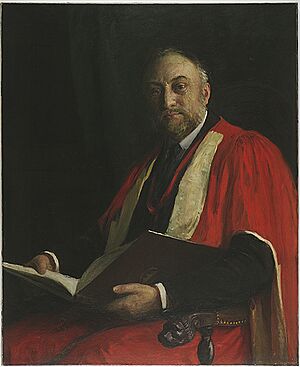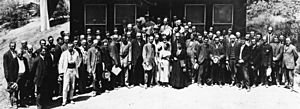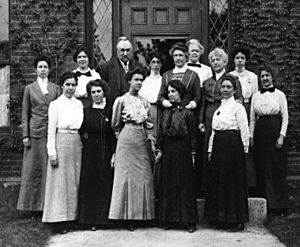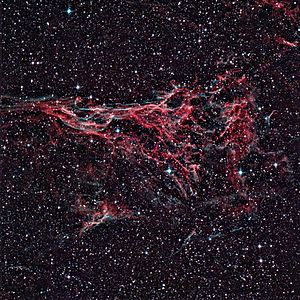Edward Charles Pickering facts for kids
Quick facts for kids
Edward Charles Pickering
ForMemRS HFRSE
|
|
|---|---|
 |
|
| Born | July 19, 1846 Boston, Massachusetts, U.S.
|
| Died | February 3, 1919 (aged 72) Cambridge, Massachusetts, U.S.
|
| Resting place | Mount Auburn Cemetery, Cambridge, Massachusetts, U.S. |
| Alma mater | Harvard |
| Known for | spectroscopic binary stars |
| Awards | Member of the National Academy of Sciences (1873) Henry Draper Medal (1888) Valz Prize (1888) Bruce Medal (1908) Gold Medal of the Royal Astronomical Society (1886 and 1901) |
| Scientific career | |
| Fields | Astronomy |
Edward Charles Pickering (born July 19, 1846 – died February 3, 1919) was an American astronomer and physicist. He was the older brother of William Henry Pickering, who was also a scientist. Edward Pickering and Carl Vogel were the first to discover spectroscopic binary stars. These are star systems that look like a single star but are actually two stars orbiting each other very closely. He also wrote a book called Elements of Physical Manipulations in two parts, published in 1873 and 1876.
Contents
Edward Pickering's Early Life and Family
Edward Charles Pickering was born in Boston, Massachusetts, on July 19, 1846. He came from a well-known family. His brother, William, later became a professor of physics and astronomy. Edward was interested in stars from a young age. He even built his own telescope when he was just 12 years old!
Besides his work, Pickering enjoyed many hobbies. He loved mountain climbing and bicycling when he was younger. Later, he enjoyed watching football games. He also helped start the Appalachian Mountain Club and was its first president. Pickering was a big fan of classical music too.
During World War I, he worked on inventions to help the war effort. One device he helped create was the Pickering Polaris Attachment. This tool was used to figure out how far away enemy targets were for guns. In 1874, Pickering married Lizzie Wadsworth Sparks. Her father used to be the President of Harvard. Mrs. Pickering passed away in 1906, and Edward died in 1919.
Edward Pickering's Education
Pickering went to Boston Latin School. After that, he studied at the Lawrence Scientific School at Harvard. This school is now known as the Harvard John A. Paulson School of Engineering and Applied Sciences. He earned his Bachelor of Science (BS) degree in 1865.
Edward Pickering's Career and Discoveries

Right after graduating from Harvard, Pickering became a math instructor there. A year later, he moved to the Massachusetts Institute of Technology (MIT). At MIT, he became an assistant professor of physics. Two years after that, he became the Thayer Professor of Physics.
During his 10 years at MIT, Pickering created the first physics lab in America for students. This lab allowed students to do their own research and publish their findings. He called it the Rogers Laboratory of Physics and was its director.
From 1877 until his death in 1919, Pickering was the director of the Harvard College Observatory (HCO). Here, he made huge progress in collecting information about stars using photography. This was a big change from the old way of just looking through telescopes.

After the death of astronomer Henry Draper, Pickering had a special opportunity. Draper had been studying astronomy using photography, but his work was unfinished. Draper's wife, Mary Anna Draper, wanted to continue his research. Pickering offered his help and advice. Mrs. Draper soon brought her husband's work to him.
Pickering realized that using photography in astronomy was very promising. It was much better than just observing with the eye. In 1884, a paper about these observations was published. To make Draper's findings stronger, Pickering hired more assistants. This also helped create the group known as the Harvard Computers.
In 1882, Pickering asked for help from astronomers around the world. He wanted them to observe variable stars (stars that change brightness). At first, there was some disagreement. But eventually, groups like the Variable Star Section of the British Astronomical Association and the American Association of Variable Star Observers (AAVSO) were formed. Pickering worked well with the AAVSO and even received a special gift from them.
In 1882, Pickering also invented a new way to photograph many star spectra at once. He did this by placing a large prism in front of the camera's photographic plate. Using this method, Pickering and his team took pictures of over 220,000 stars! This huge collection of photos gave scientists a massive library of star movements for decades. It's said that this research weighed 120 tons because of the size of the photographic plates.
Pickering, along with Williamina Fleming and Annie Jump Cannon, also created a system to classify stars. This system used letters of the alphabet based on the stars' spectra (the light they give off). It was first called the Harvard Stellar Classification system. It later became the basis for the famous Henry Draper Catalog.
In 1896, Pickering observed new lines in the light spectrum of the star ζ-Puppis. These lines became known as the Pickering series. At first, Pickering thought they came from hydrogen. Later, in 1912, Alfred Fowler saw similar lines in a mix of hydrogen and helium. However, Niels Bohr (a famous physicist) showed that these lines actually came from ionized helium (He+), not hydrogen. This discovery was important because it helped confirm Bohr's new ideas about how atoms are built.
Pickering is remembered for making the Harvard College Observatory famous worldwide. It is still a highly respected observatory and research center today.
The Harvard Computers: Women in Astronomy

As the Harvard College Observatory grew, it needed more assistants. These assistants were very important for taking notes, doing calculations, and analyzing data. Many college-educated women from across the country offered to work for free at the observatory. They wanted to gain experience or prove their skills to get paid.
Pickering hired over 80 women to work for him. Some of these amazing women included Annie Jump Cannon, Henrietta Swan Leavitt, Antonia Maury, and Florence Cushman. It was very unusual for a famous scientist to work with so many women at that time. It is said that he once became so frustrated with his male assistant's work that he joked his maid could do a better job!
These women, known as the Harvard Computers, made many important discoveries at the observatory. For example, Henrietta Swan Leavitt discovered a relationship between how bright a certain type of star (called a Cepheid) is and how quickly its brightness changes. This discovery, published by Pickering, became key to understanding distances in space.
Even though the women were paid less than men and often didn't get as much credit, Pickering's willingness to include them was groundbreaking. He opened doors for many talented female scientists and leaders in astronomy. This also helped the observatory get more funding and support.
Edward Pickering's Legacy
Pickering was the fourth director of the Harvard College Observatory. He held the position for 42 years, which is the longest of any director. On February 3, 1919, he sadly died from pneumonia and heart problems. He passed away while still serving as director, continuing a strange tradition of HCO directors dying in office. After his death, Solon Bailey took over temporarily.
Pickering's friends and colleagues remembered him as a very capable, original, and kind-hearted person. The world remembers him for his huge contributions to astronomical photography. He also advanced many astronomical discoveries and had a forward-thinking view about women in science.
While some might see his treatment of women as unfair by today's standards, he was known for giving women more equal opportunities than most people at the time. His actions paved the way for many more women to get involved in astronomy. Pickering's work with glass plates to photograph the sky led to major technological advances. Although glass plates are no longer used, his work led to the development of modern charged coupled devices (CCDs) in the 1970s, which are used in digital cameras today.
Edward Pickering is buried in Mount Auburn Cemetery in Massachusetts.
Honors and Awards for Edward Pickering
Edward Pickering received many awards and honors:
- He was the youngest person ever elected a Member of the National Academy of Sciences in 1873, at just 26 years old.
- He became a Fellow of the American Academy of Arts and Sciences in 1867.
- He received the Gold Medal of the Royal Astronomical Society twice (in 1886 and 1901).
- He won the Valz Prize from the French Academy of Sciences in 1888.
- He was awarded the Henry Draper Medal from the National Academy of Sciences in 1888.
- He received the Bruce Medal in 1908.
- He won the Prix Jules Janssen, the top award from the French astronomical society, in 1908.
- He received honorary doctor degrees (LL. D.) from six American universities and two foreign universities.
- He was given the Rumford Medal.
- He received the Pour le Merite award.
Several things in space are named in his honor:
- The lunar crater, Pickering
- The Martian crater, Pickering
- The Asteroid 784 Pickeringia
- A part of the Veil Nebula called Pickering's Triangle
- Mount Pickering, a mountain in California
Edward Pickering's Publications
- (1873–76) Elements of physical manipulation
- (1882) A plan for securing observations of the variable stars
- (1886) An investigation in stellar photography
- (1891) Preparation and discussion of the Draper catalogue
- (1903) Plan for the endowment of astronomical research
Images for kids
See also
 In Spanish: Edward Charles Pickering para niños
In Spanish: Edward Charles Pickering para niños



